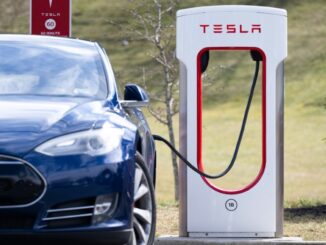
In a rapidly evolving energy landscape, natural gas companies are facing an era of heightened price swings, according to Expand Energy CEO Nick Dell’Osso. Speaking on the challenges ahead, Dell’Osso emphasized the need for agile strategies, stating, “Successful drilling companies will need a strategy to quickly dial up or down their production.”
This warning comes amid surging global demand and infrastructure constraints, with factors like data center expansion, liquefied natural gas (LNG) export growth, and new power plant developments poised to amplify volatility.
Are you Paying High Taxes in New Jersey, New York, or California?
Surging Data Center Demand Fuels Natural Gas Consumption
The boom in artificial intelligence (AI) and cloud computing is driving unprecedented electricity needs from data centers, significantly boosting natural gas demand. Projections indicate that data center power consumption could rise to 4,193 billion kilowatt-hours (kWh) in 2025, up from a record 4,097 billion kWh in 2024, with much of this growth reliant on gas-fired generation.
Studies suggest data centers may require an additional 10,000 megawatts (MW) by 2030, equivalent to nearly 2 billion cubic feet per day (Bcf/d) of natural gas.
In regions like Texas and Louisiana, a significant ramp-up in gas-fired power for new data centers is expected through the second half of the decade.
The International Energy Agency (IEA) forecasts global data center electricity demand to more than double to around 945 terawatt-hours (TWh) by 2030.
In the U.S., this could add up to 6 Bcf/d of gas demand by 2030, based on 290 projected projects.
Utilities are reporting advanced discussions for over 3 gigawatts (GW) of new hyperscale data center load, with an additional 4 GW in early stages.
The Energy Information Administration (EIA) anticipates natural gas prices to rise in 2025 due to this demand, alongside LNG exports.
Behind-the-Meter Contracts: A Direct Path to Power
To bypass grid constraints and secure reliable energy, data center operators are increasingly turning to behind-the-meter (BTM) private contracts, where natural gas generators supply power directly onsite. This approach allows developers to avoid interconnection delays and leverage abundant U.S. gas supplies.
For instance, International Electric Power plans a 944-MW BTM gas-fired plant in Pennsylvania to power a data center.
BTM strategies are gaining traction as utilities struggle with rising loads, with direct natural gas pipelines ensuring uninterrupted fuel.
Developers are also monetizing undervalued gas resources through these setups, sidestepping grid bottlenecks.
Legal considerations in power purchase agreements focus on siting, load characteristics, and regulatory hurdles.
This trend is expected to grow, with some operators building renewable or gas assets directly alongside facilities.
New Natural Gas Plants Coming Online
To meet escalating demand, a wave of new natural gas power plants is in the pipeline. As of mid-2025, over 114,000 MW of gas capacity is under construction or in pre-construction phases.
Developers plan to add 1.6 GW of combined-cycle gas turbines (CCGT) in 2025 alone.
Notable projects include three gas-fired plants totaling 2.25 GW for Meta’s $10 billion data center.
While renewables like solar (74% of 2025 additions) dominate new capacity, gas remains crucial for baseload power.
The U.S. has averaged 9.6 GW of new gas capacity annually over the past two decades, a pace likely to continue.
However, retirements of 4.1 GW of gas-fired capacity are slated for 2025, offset by new builds.
Robust pipeline projects are supporting this expansion, particularly for data centers.
LNG Exports Drive Global Demand Growth
U.S. LNG exports are set for substantial increases, further straining domestic supplies and contributing to price volatility. Exports surged 21% in the first half of 2025, with projections reaching 14.6 Bcf/d annually.
The EIA forecasts LNG exports to grow to 9.8 trillion cubic feet (Tcf) by 2040, more than double 2024 levels.
Combined North American LNG exports (U.S., Canada, Mexico) could rise 27% or 32 billion cubic meters (Bcm) in 2025.
Globally, LNG export capacity is projected to expand 40% in the next five years, with U.S. projects playing a key role.
New facilities’ startup timing could add 0.2 Bcf/d more exports in 2025 under optimistic scenarios.
This growth, alongside data center demand, is expected to push prices higher.
Navigating Volatility: Opportunities for Investors
Amid these dynamics, natural gas prices are poised for fluctuations due to “large, chunky volumes” of new supply hitting the market, potentially causing periodic crashes.
Investors can capitalize on this volatility through several strategies. Futures contracts and funds holding them provide direct exposure to price swings, allowing bets on upward or downward movements.
Diversifying across the sector—upstream producers, midstream pipelines, and downstream users—helps mitigate risks, as midstream firms often pass price changes to customers, stabilizing profits.
Long-term investments in companies with strong assets, like larger drillers better equipped to handle volatility, can yield better returns.
Volatility influences investment decisions, with uncertainty potentially deterring exploration but rewarding agile players.
For risk-tolerant investors, commodities trading offers potential high returns, though it should be part of a balanced portfolio.
Spreading investments reduces the impact of fluctuations.
Overall, while price risks exist from supply-demand imbalances and geopolitical factors, the sector’s growth drivers present profitable avenues for informed investors.
Avoid Paying Taxes in 2025
Crude Oil, LNG, Jet Fuel price quote
ENB Top News
ENB
Energy Dashboard
ENB Podcast
ENB Substack






